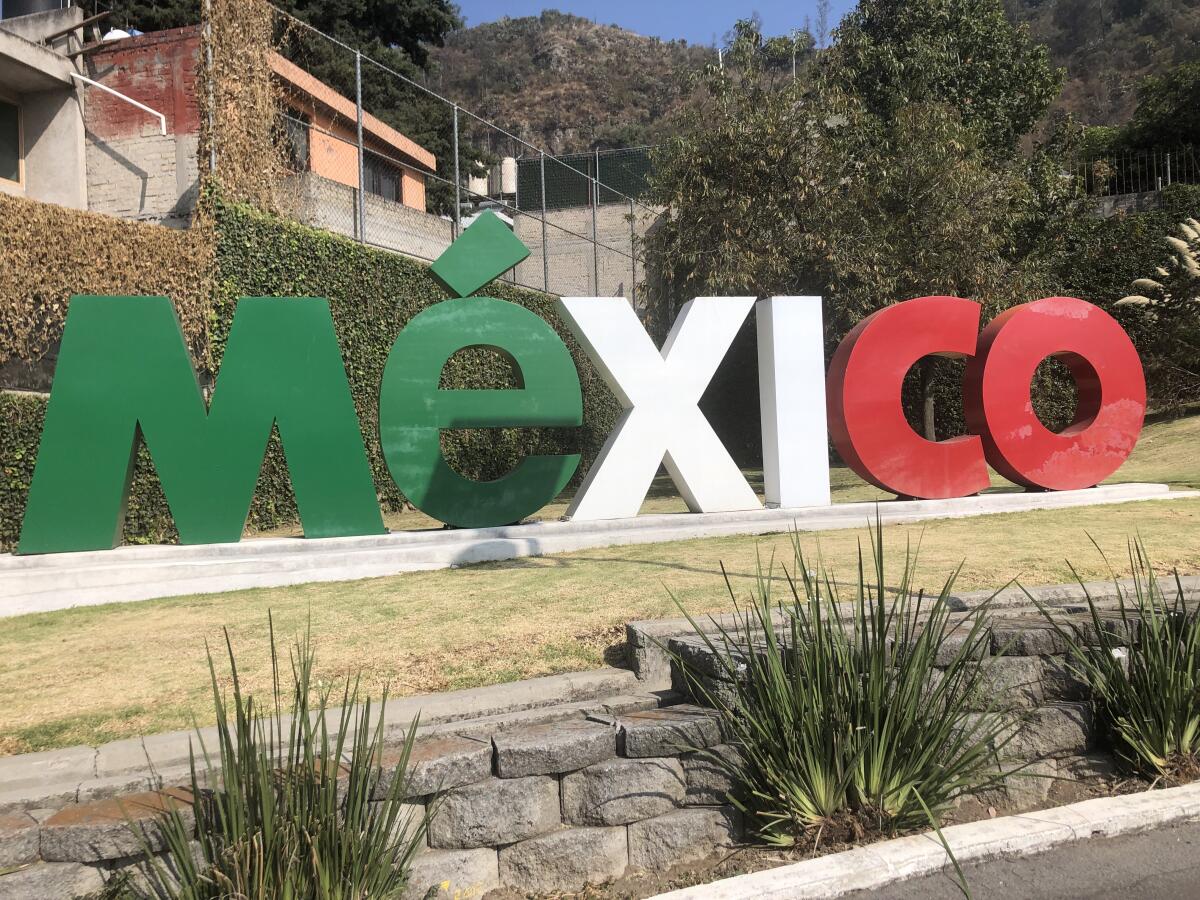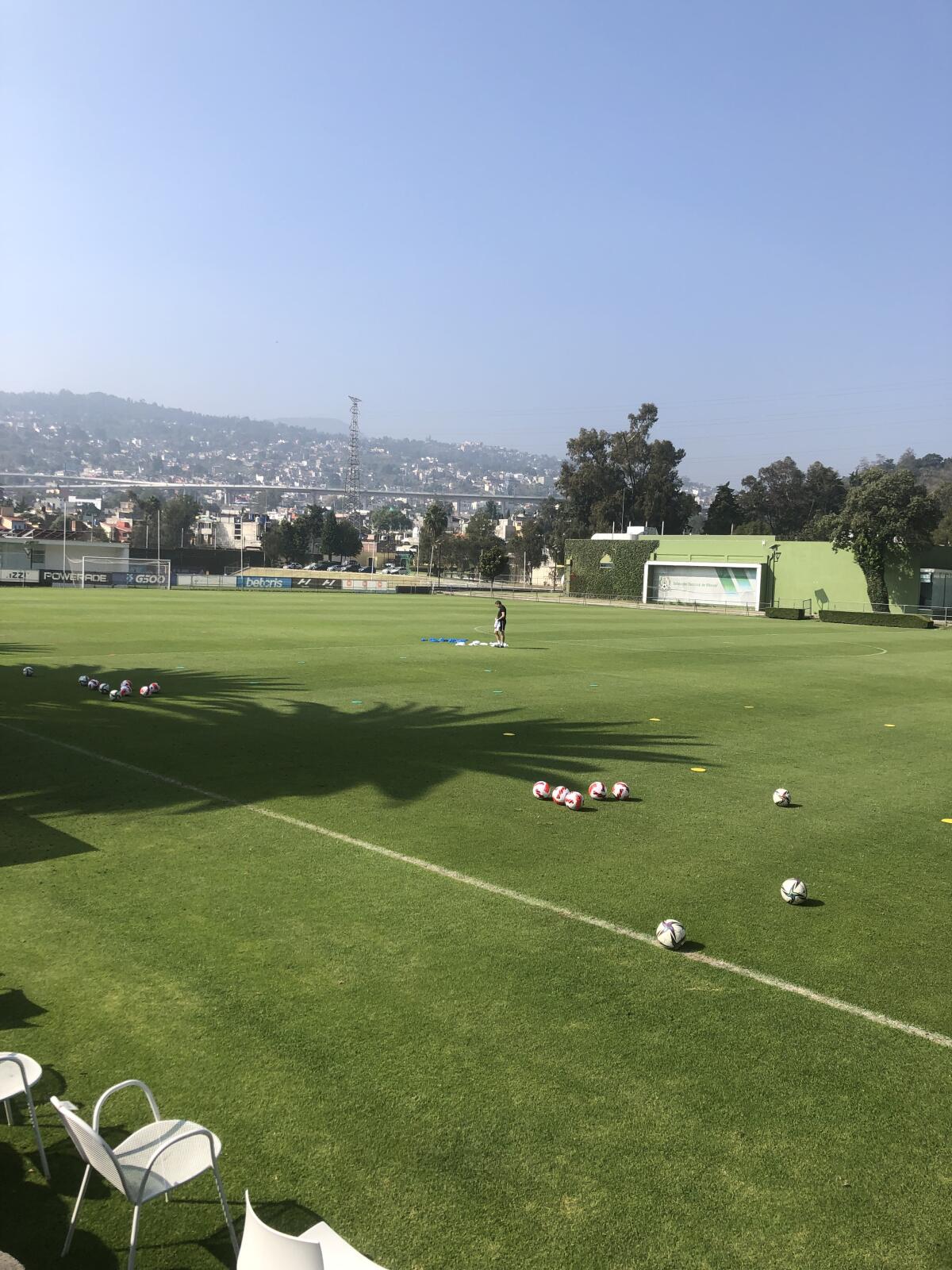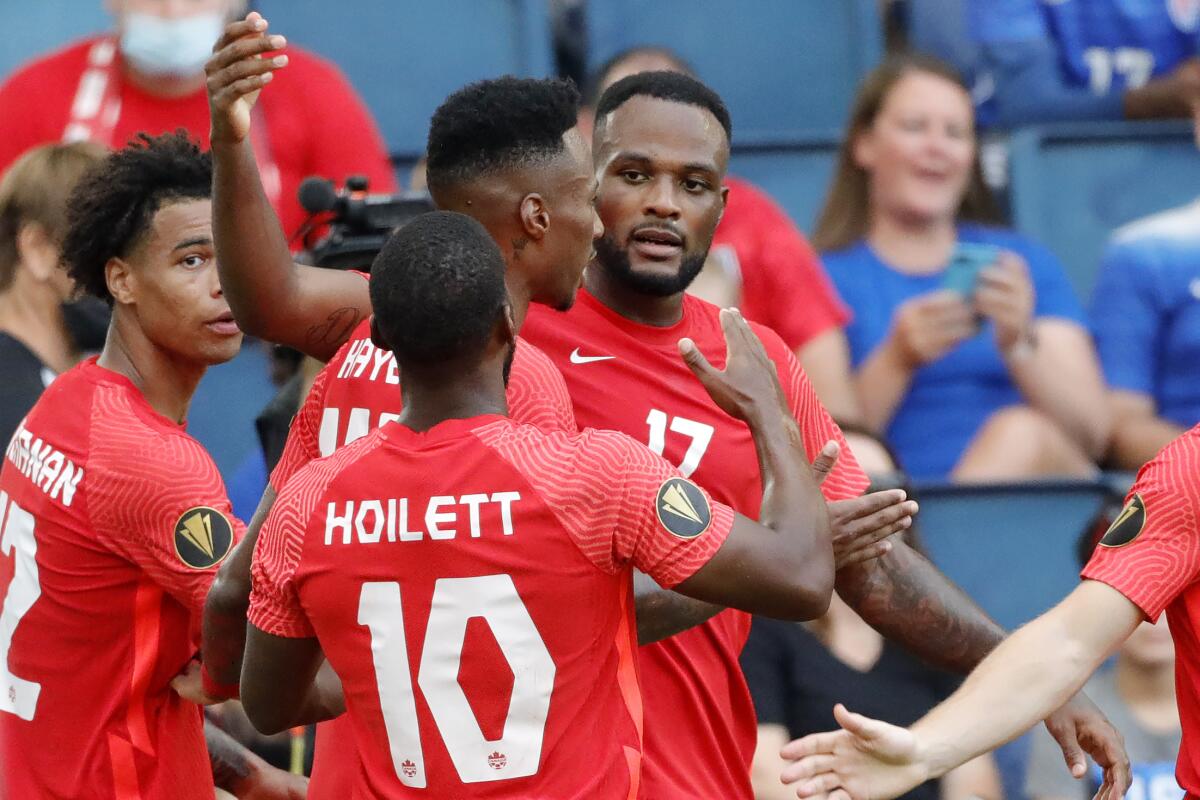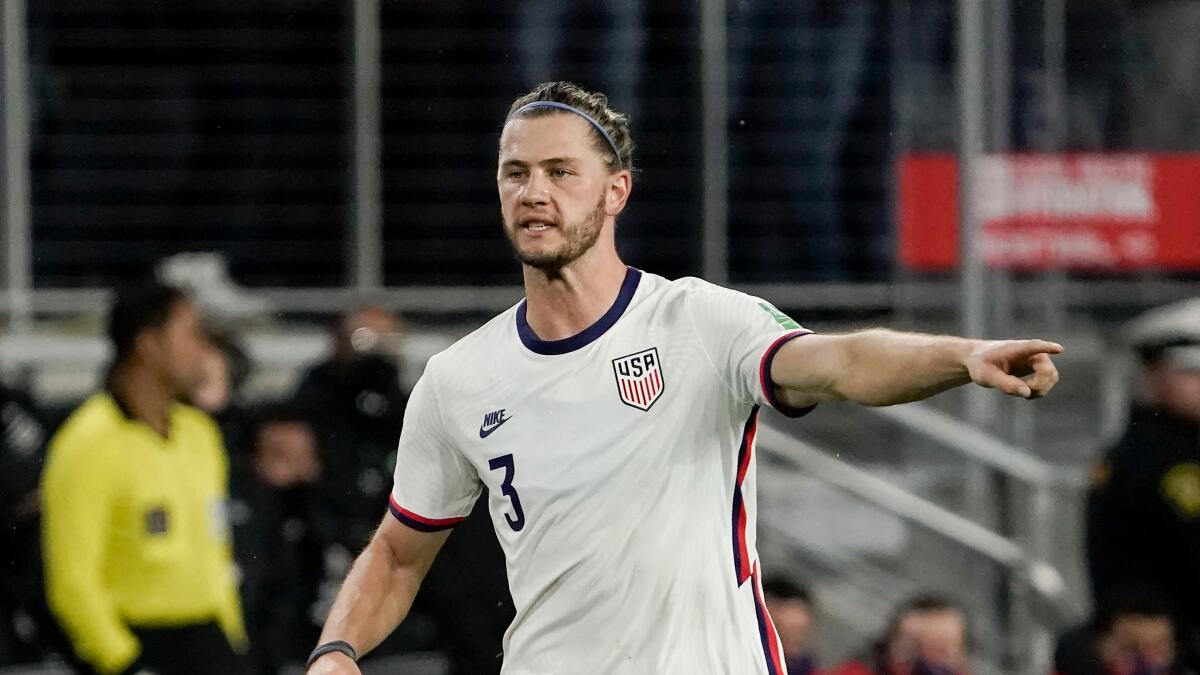Soccer newsletter: Mexico’s elite soccer training facility gives El Tri an edge

- Share via
MEXICO CITY — Hello, and welcome to the weekly L.A. Times soccer newsletter. I’m Kevin Baxter, the Times’ soccer writer, and we start today in Mexico City, home to the Mexican federation’s high-performance training center.
The compact facility, squeezed into a largely residential neighbor, boasts three full soccer fields, two half fields, a beach soccer pitch, offices, a press center and auditorium, locker rooms, two dormitory buildings, an airy state-of-the-art gymnasium, a physiotherapy and rehabilitation unit and a cafeteria.
The center, located just south of Mexico City in Colonia Dolores Tlali, can handle three national teams at the same time and hosts as many as 80 training camps a year. The U.S. has nothing like it — much to the chagrin of the men in charge of the country’s two senior national teams.
“It’s beneficial for us to have a national training center,” said men’s coach Gregg Berhalter, whose team began preparing for the next round of World Cup qualifiers Monday in Columbus, Ohio, the third state in which the U.S. has gathered to train since early December. “Not only for consistency of the senior team, but also to have all the other teams there as well.
“I’ve been around the world and was lucky enough to see some of the national training facilities of other countries, like St. George’s in England. And it’s a laboratory. You see all the coaches interacting, you see the teams there and the players feel at home. I would much prefer that.”
So would Vlatko Andonovski, coach of the women’s national team.
“I’m sure our admin and the equipment managers would agree that would make their life so much easier,” said Andonovski, whose team will train in three U.S. cities before playing its first game this year at Dignity Health Sports Park.
“There are pros and cons to everything. But I do like the idea of having a centralized location where not just the senior national team is, or the CEO or the senior technical staff is, but the youth national teams and the youth national team staff. Everybody’s there.”
Mexico has that, and it has found the pros heavily outweigh the cons. The training center, federation president Yom de Luisa said, gives Mexico a huge competitive edge over countries that don’t have one.
“The requirements of all the national teams have grown drastically throughout the last years,” said De Luisa, whose federation maintains the privately financed training base out of an overall annual budget of about $100 million. “So we are looking forward to improving it with an additional pitch and an additional beach [pitch] and with modern facilities that will help us improve our day-to-day ability of servicing all our women’s and men’s national teams.”
Enjoying this newsletter? Consider subscribing to the Los Angeles Times
Your support helps us deliver the news that matters most. Become a subscriber.
The federation’s administrative and operations offices, meanwhile, share a modern eight-acre complex with the country’s domestic Liga MX about an hour southwest of the capital in Toluca. That six-year-old facility, the base for many of the 530 staff members employed by the federation and the league, has three turf fields, two grass fields and a 4,000-seat stadium in addition to a gym and locker rooms primarily used for training by referees, some Liga MX teams, youth national teams and non-pro athletes.
Finding the Mexican national team’s high-performance center — known as the CAR, or Centro de Alto Rendimiento in Spanish — requires patience and a good GPS in order to navigate the warren of progressively narrowing streets, which eventually reveal a yellow concrete-block compound topped by barbed wire and bordered on two sides by a military base. The center, on a bluff that affords a spectacular view of the nearby city, was inspired by Barcelona’s famed La Masia youth academy.

It opened in 2003, then underwent extensive renovations in 2020 when the COVID-19 pandemic kept the teams and coaches away. This winter, however, it’s been a hub of activity.
“I have no need to compare. What I am seeing, the facilities meet our needs when training and in camp,” men’s coach Tata Martino, speaking in Spanish, said from behind a desk in a Spartan office in the facility’s media center. “The truth is the CAR is an unbeatable place to work.”
Its presence also raises the stakes for the likes of Martino and Mónica Vergara, coach of the women’s national team.
“Whoever we hire, they know what they are coming to,” De Luisa said. “They know the expectations. They know the facilities. So there’s actually no excuses. Not for the head coaches, not for the sports directors, not for the president and not for the players, of course.”
The amenities are just part of what makes the CAR important for the Mexican federation. The center’s location in the middle of Mexico, no more than three hours by air from the farthest reaches of the country, make it accessible. It’s also at altitude and close to Estadio Azteca, the national team’s home stadium.
Constructing a similar center — or even deciding where to build one — would be much more difficult in a continent-sized country like the U.S. Weather concerns would rule out much of the northeast and upper midwest, for example. The weather on the West Coast is friendlier, but crossing 10 time zones on the 12-hour flight from central Europe would be taxing for the growing number of first-team players who are on club teams there.
“There’s so many other things that need to be considered obviously,” said Andonovski, who lives in Kansas City. “Where can you put that complex weather-wise? Do we want to put it closer to Europe or closer to Asia?
“I haven’t thought about a perfect location. If you asked me, I’ll probably put it in Kansas City just because it’s going to be close to my house.”
The U.S. does have the Elite Athlete Training Center in Chula Vista, a multi-sport facility with several soccer fields, a gym, dorm rooms and cafeteria. It has been used for several national training camps, including Berhalter’s first as U.S. manager in 2018. U.S. Soccer also has facilities — including locker rooms and office space — at Dignity Health Sports Park in Carson and a permanent facility in Kansas City, Kans., for the education of coaches and referees.
But none of those can be considered a true national training center like the one Mexican soccer has built. So Andonovski, who grew up in North Macedonia, a tiny country of less than 2 million people — but one that, nonetheless, has a national training center -- insisted on making the best of the situation in the U.S.
“I do also love the idea of being around the country and being in front of some of the fans in different markets, experiencing or playing games in front of those fans,” said Andonovski, who has coached his team in a dozen U.S. markets in his 26 months as manager. “So, like I said, there are pros and cons to everything.”
Whoa, Canada!
Canada heads into the resumption of World Cup qualifying this week atop the eight-team CONCACAF table as the only unbeaten team in the tournament. With six qualifiers left, Canada’s second World Cup appearance is well within reach.
The Canadian women, meanwhile, are the reigning Olympic champions and ranked sixth in the world by FIFA.
In a country where curling is considered a legitimate sport, soccer is enjoying a golden era — an era for which Anthony Totera has waited much of his life.
“It’s like being a Chicago Cubs fan,” said Totera, the lead domestic scout and head of community engagement for York United, a Toronto-based club which plays in the Canadian Premier League, the country’s top domestic professional soccer league. “I’m that guy that stuck through it.”
That’s putting it mildly. Totera, whose owes his appreciation for soccer to his Italian-immigrant family, has been following the Canadian national team since its only World Cup appearance in 1986, when it was shut out in three consecutive losses. That was so long ago that one of the countries Canada played, the Soviet Union, no longer exists.

Totera was 16 then. He’s 52 now and his national team, which plays in Honduras on Thursday before playing host to the U.S. in frigid Hamilton, Ontario on Sunday, not only is closing in on a second World Cup invitation, but in four years the men’s tournament will come to Canada.
The difference between soccer’s profile in the Great White North then and now is stark, he said.
“It was lonely days back 35, 40 years ago, where no one could care about Canada,” he said. “Now everyone’s on the bandwagon, which I’m happy for.”
One of Totera’s first jobs was at a sports-talk radio station in Toronto, where the station manager urged him to talk about the PGA, LPGA, NASCAR — anything with initials — rather than soccer.
Totera wouldn’t change his mind, so the station manager eventually asked him to change jobs — which he did. He wandered unannounced into the offices of the North York Rockets of the now-defunct Canadian Soccer League and asked if he could help. He’s been working in pro soccer ever since, hosting a soccer podcast, then spending 4 ½ years with the Canadian Premier League in football development and special operations before joining York United.
That experience gave him a front-row seat to watch the growth and development of the national team, which last played in the final round of CONCACAF World Cup qualifying in 1998. It won one of 10 games and was outscored 20-5.
“Boy oh boy, there’s a lot of us that took ridicule and mocking back in the day,” Totera said.
There’s nothing to mock about this year’s team, which features versatile wing back Alphonso Davies, widely regarded, at 21, as the best player in CONCACAF. Davies, who plays for Bayern Munich, won’t participate in Canada’s three games in this qualifying window; he’s temporarily sidelined due to signs of the heart condition myocarditis.
But Canada has 13 other players who are with top European clubs, including forwards Cyle Larin, 26, who plays in Turkey with Besiktas, and 22-year-old Jonathan David, of French club Lille.
“I believe in this young squad,” Totera said. “They’re fearless. They’re confident. They’re rallying together. They’re very, very united.”

And their success is changing the way Canadians look at the sport. Hockey is still the national pastime, but the national soccer team has finally gone prime time.
“Oh yeah it’s changing, just like it changed for basketball when the Toronto Raptors won,” Totera said.
“There’s finally a pathway to play professional football in our country with the Canadian Premier League. Basketball and soccer right now are really knocking hard on the door of hockey.”
Totera, it would seem, finally has gotten what he was waiting for.
Baby, it’s gonna be cold outside
Temperatures are forecast to range from the low teens to the mid 20s for the U.S. national team’s upcoming World Cup qualifiers with El Salvador in Columbus, Ohio, on Thursday; in Canada on Sunday and against Honduras in St. Paul, Minn., on Feb. 2.
And defender Walker Zimmerman, who grew up in suburban Atlanta and spent most of his MLS career in Dallas and Los Angeles, said he is welcoming the cold.
“I want it to be freezing. I want it to be cold. I want the snow,” said Zimmerman, who remembers watching on TV as the U.S. beat Mexico in a mid-20s wind-chill in Columbus in 2001. “I want to be part of something so iconic. That’s exciting to me.
“I think the guys are ready to embrace it.”
Berhalter believes the weather will give the U.S. a decided edge over El Salvador and Honduras.

Fifteen of the 28 players on the roster Berhalter called up Friday play for clubs in Europe while all but a handful of the players with El Salvador and Honduras play in Central America.
“This is an opportunity to gain an advantage on our opponents,” he said. “They’re all coming from the equator and it’s going to be really difficult for them to deal with these conditions. They’re going to take a couple of breaths in and it’s going to hit them like they’ve never been hit before.”
The cold could even give the U.S. a big edge over Canada, which last November beat Mexico 2-1 in Edmonton in a wind chill of 5 degrees. It was the coldest game in Mexican national team history.
The kind of weather could work against Canada this time.
The team will play Honduras on Thursday in San Pedro Sula, where the forecast calls for temperatures of 80 degrees with a 78% humidity. Canada then will fly to frigid Hamilton, where it will play host to the U.S. in sub-freezing weather before returning to Central America to play El Salvador, where daytime temperatures are expected to approach 90 degrees.
While Canada is trying to adjust to heat, cold and heat again, the U.S. team isn’t expected to see temperatures above freezing for the next eight days. Berhalter said that could make the weather a plus for the U.S.
“It’s a mindset. It’s mind over matter,” said the coach, who remembers wearing short sleeves for a game he played in Germany in -15-degree weather. “Once you get running, once you get sweating, you’re good to go.”
CONCACAF World Cup qualifying table
Pts. W-L-T GF GA GD
Canada 16 4-0-4 13 6 7
U.S. 15 4-1-3 12 5 7
Mexico 14 4-2-2 11 7 4
Panama 14 4-2-2 11 9 2
Costa Rica 9 2-3-3 6 7 -1
Jamaica 7 1-3-4 6 10 -4
El Salvador 6 1-4-3 4 10 -6
Honduras 3 0-5-3 5 15 -10
Next games
Thursday
U.S. vs. El Salvador, Columbus, Ohio
Costa Rica vs. Panama
Jamaica vs. Mexico
Honduras vs. Canada
Sunday
U.S. at Canada, Hamilton, Canada
Mexico vs. Costa Rica
Honduras vs. El Salvador
Panama vs. Jamaica
Feb. 2
U.S. vs. Honduras, St. Paul, Minn.
Jamaica vs. Costa Rica
Mexico vs. Panama
El Salvador vs. Canada
And finally there’s this….
Speaking of the World Cup, if you want to go see games in Qatar this fall it will cost you. Tickets for the final will average between $604 to $1,000, up 46% from the 2018 tournament in Russia. The most expensive ticket for the final is $1,607, $500 more than 2018. (But compared to the average ticket price of more than $4,000 for next month’s Super Bowl at SoFi Stadium, the World Cup final is a steal.) There are other bargains too: For the group stage, Qatari residents can buy World Cup tickets for as little as $11, the lowest price since 1986; the cheapest ticket for non-Qataris is $69, lowest since 2006. FIFA hopes to generate $500 million from hospitality rights and ticket sales. The first sales period opened last Wednesday and will continue through Feb. 8 at FIFA.com/tickets … Galaxy defender Julian Araujo was called up by Mexico for that country’s upcoming World Cup qualifiers with Jamaica, Costa Rica and Panama. Araujo has not played in a competitive game for Mexico since changing his allegiance from the U.S. last October.
Quotebook
“We are all here because we started playing in our childhood with a ball, and I think Steve wants us to feel that joy here. Of course we are here to win games, but the closest way to win is if we enjoy what we do.”
New LAFC midfielder Ilie Sánchez on the atmosphere created by LAFC coach Steve Cherundolo during the team’s first week of preseason training
Until next time...
Stay tuned for future newsletters. Subscribe here, and I’ll come right to your inbox. Something else you’d like to see? Email me. Or follow me on Twitter: @kbaxter11.
Go beyond the scoreboard
Get the latest on L.A.'s teams in the daily Sports Report newsletter.
You may occasionally receive promotional content from the Los Angeles Times.




